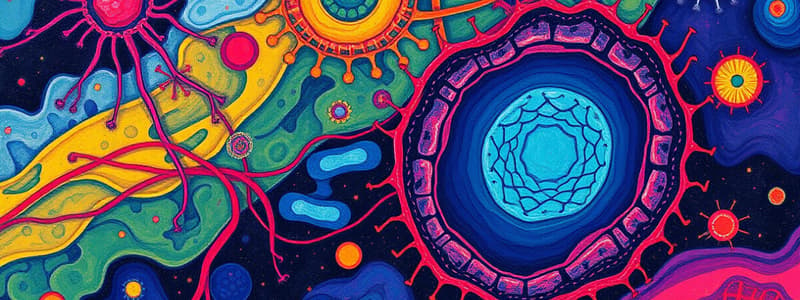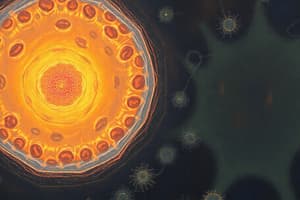Podcast
Questions and Answers
What is a defining characteristic of prokaryotic cells?
What is a defining characteristic of prokaryotic cells?
- Complex organelles
- Multiple cellular membranes
- Presence of a nucleus
- Nucleoid region with DNA (correct)
Which of the following is NOT part of the cell theory?
Which of the following is NOT part of the cell theory?
- All living things are made of cells
- Cells are the basic unit of structure and function
- Cells come from the reproduction of existing cells
- Cells arise from spontaneous generation (correct)
What distinguishes eukaryotic cells from prokaryotic cells?
What distinguishes eukaryotic cells from prokaryotic cells?
- The absence of ribosomes
- The presence of membrane-bound organelles (correct)
- The simpler structure
- The smaller size compared to prokaryotic cells
Which kingdoms include eukaryotic organisms?
Which kingdoms include eukaryotic organisms?
Who formulated the cell theory?
Who formulated the cell theory?
What is the primary function of the Rough Endoplasmic Reticulum (Rough ER)?
What is the primary function of the Rough Endoplasmic Reticulum (Rough ER)?
Which structure is responsible for modifying, sorting, and packaging molecules from the ER?
Which structure is responsible for modifying, sorting, and packaging molecules from the ER?
What distinguishes the Smooth Endoplasmic Reticulum (Smooth ER) from the Rough ER?
What distinguishes the Smooth Endoplasmic Reticulum (Smooth ER) from the Rough ER?
Which of the following accurately describes the function of ribosomes?
Which of the following accurately describes the function of ribosomes?
What is located within the interior of the Rough Endoplasmic Reticulum during protein synthesis?
What is located within the interior of the Rough Endoplasmic Reticulum during protein synthesis?
Which statement best describes the structure of Golgi Bodies?
Which statement best describes the structure of Golgi Bodies?
What role does the Smooth Endoplasmic Reticulum play in muscle cells?
What role does the Smooth Endoplasmic Reticulum play in muscle cells?
Which of the following processes does the Golgi Bodies NOT perform?
Which of the following processes does the Golgi Bodies NOT perform?
What is the primary function of the cell membrane?
What is the primary function of the cell membrane?
Which organelle is responsible for making ribosomes?
Which organelle is responsible for making ribosomes?
What is the role of the cytoplasm in a cell?
What is the role of the cytoplasm in a cell?
What is the primary composition of the cytoskeleton?
What is the primary composition of the cytoskeleton?
Which of the following statements about mitochondria is true?
Which of the following statements about mitochondria is true?
Where are centrioles found?
Where are centrioles found?
What defines the structure of the cell membrane?
What defines the structure of the cell membrane?
Which component is a part of the cytoskeleton?
Which component is a part of the cytoskeleton?
What is the function of the nucleus in a cell?
What is the function of the nucleus in a cell?
What role do genes play in a cell?
What role do genes play in a cell?
What is the primary function of lysosomes in a cell?
What is the primary function of lysosomes in a cell?
Which of the following accurately describes vacuoles in plant cells?
Which of the following accurately describes vacuoles in plant cells?
Which component is NOT part of the process of homeostasis?
Which component is NOT part of the process of homeostasis?
What is autolysis in relation to lysosomes?
What is autolysis in relation to lysosomes?
Chloroplasts are primarily found in which type of organisms?
Chloroplasts are primarily found in which type of organisms?
What structure in chloroplasts is responsible for the light-dependent reactions of photosynthesis?
What structure in chloroplasts is responsible for the light-dependent reactions of photosynthesis?
Which substance is primarily produced by chloroplasts during photosynthesis?
Which substance is primarily produced by chloroplasts during photosynthesis?
Which process allows cells to take in food through lysosomes?
Which process allows cells to take in food through lysosomes?
What role does the hypothalamus play in maintaining homeostasis?
What role does the hypothalamus play in maintaining homeostasis?
Which of the following components is NOT part of the nervous system?
Which of the following components is NOT part of the nervous system?
What component of the endocrine system is primarily responsible for sending hormones into the bloodstream?
What component of the endocrine system is primarily responsible for sending hormones into the bloodstream?
In what way do hormones affect the muscular system?
In what way do hormones affect the muscular system?
Which of the following is a characteristic of negative feedback in homeostatic control?
Which of the following is a characteristic of negative feedback in homeostatic control?
Which division of the autonomic nervous system is primarily active during stress responses?
Which division of the autonomic nervous system is primarily active during stress responses?
How do hormones influence the cardiovascular system?
How do hormones influence the cardiovascular system?
Which system is responsible for the secretion of sex hormones affecting reproductive development?
Which system is responsible for the secretion of sex hormones affecting reproductive development?
Study Notes
Prokaryotes and Eukaryotes
- Prokaryotes possess a nucleoid region containing DNA and lack membrane-bound organelles.
- Ribosomes in prokaryotes synthesize proteins within the cytoplasm.
- Eukaryotes are characterized by a nucleus and membrane-bound organelles, including protists, fungi, plants, and animals.
- Eukaryotic cells are generally more complex than prokaryotic ones.
Cell Theory
- Formulated by Theodor Schwann and Matthias Schleiden in 1838.
- Key principles include:
- All living things consist of cells.
- Cells are the basic unit of structure and function in organisms.
- New cells arise from the division of existing cells.
Whittaker's Five Kingdoms of Classification
- Divides life into five kingdoms based on cellular organization and features.
- Prokaryotic organisms are unicellular and lack a nucleus, while the other kingdoms comprise eukaryotic organisms.
Cell Structure and Organelles
- Organelles are microscopic structures performing specific cell functions, found in the cytoplasm.
- Cell membranes consist of a phospholipid bilayer with embedded proteins, regulating the entry and exit of substances.
- Cytoplasm is a jelly-like medium that supports organelles and biochemical reactions.
Nucleus and Nucleolus
- The nucleus controls cell activities and houses DNA within chromosomes, surrounded by a nuclear envelope with pores.
- Nucleolus, found inside the nucleus, produces ribosomes necessary for protein synthesis.
Cytoskeleton and Centrioles
- The cytoskeleton maintains cell shape and aids in organelle movement, made of microfilaments (actin) and microtubules (tubulin).
- Centrioles, present only in animal cells, help in cell division by forming the mitotic spindle.
Mitochondria
- Mitochondria, known as the "powerhouse" of the cell, generate ATP through cellular respiration.
- They contain their own DNA and are inherited maternally, with a folded inner membrane (cristae) to enhance surface area for reactions.
Endoplasmic Reticulum (ER)
- The ER is a network of membrane tubules involved in synthesizing and transporting cell products.
- Rough ER has ribosomes attached and synthesizes proteins; Smooth ER lacks ribosomes and synthesizes lipids and detoxifies substances.
Ribosomes and Golgi Bodies
- Ribosomes are protein synthesis factories, either attached to Rough ER or free in the cytoplasm.
- Golgi bodies modify, sort, and package proteins received from the ER, resembling stacks of pancakes with cis (receiving) and trans (shipping) faces.
Lysosomes and Vacuoles
- Lysosomes contain digestive enzymes for breaking down food and worn-out cell parts, with roles in cellular recycling.
- Vacuoles are storage sacs; plant cells have a prominent central vacuole, while animal cells typically have smaller vacuoles.
Chloroplasts
- Chloroplasts are found only in photosynthetic organisms, enabling them to convert sunlight into glucose through photosynthesis.
- They include thylakoids (sacs containing chlorophyll) and stroma (gel-like fluid) and possess their own DNA.
Homeostasis
- Homeostasis maintains a stable internal environment necessary for cell survival, regulating factors like oxygen, glucose, and waste removal.
- Physiological control systems involve a sensor, afferent pathway, integration center, efferent pathway, and effectors.
Nervous and Endocrine Systems
- The nervous system regulates homeostasis by responding to stimuli and directing the body's adaptive responses through the central and peripheral systems.
- The endocrine system comprises glands that secrete hormones affecting various body functions, including metabolism, growth, and inflammation.
- Negative feedback is a crucial mechanism that opposes deviations from set points, ensuring physiological stability.
Studying That Suits You
Use AI to generate personalized quizzes and flashcards to suit your learning preferences.
Related Documents
Description
This quiz covers the fundamental differences between prokaryotic and eukaryotic cells. Learn about their structures, functions, and roles in biology. Perfect for students studying cellular biology.




